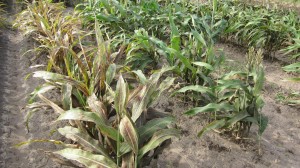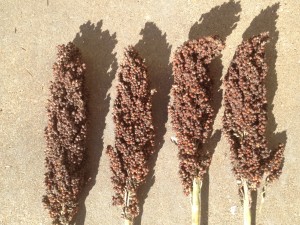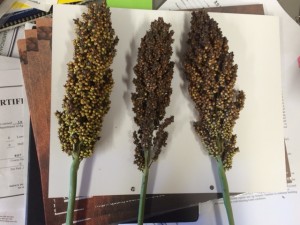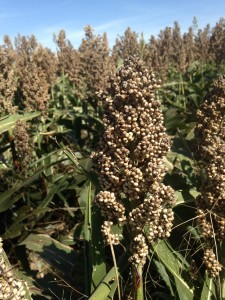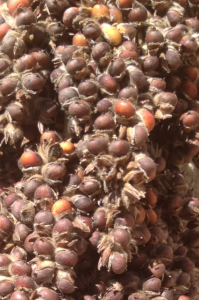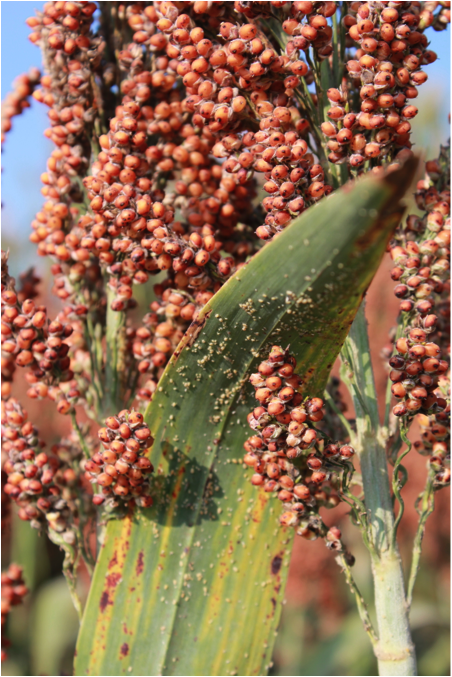Baling Sorghum Stalks II – Loss of Soil Cover Protection
Statewide
In my last tip I discussed the often misunderstood removal of nutrients in sorghum stalks baled off the field and the potential replacement cost of those nutrients. Many producers are probably not receiving enough income per ton of sorghum stalk hay to adequately compensate themselves for his hidden cost.
It is not easy or simple to quantify the value of having soil surface cover on the field. This is especially important in Texas the windier, sandier, and drier your crop production environment is. If you have high sorghum stalk biomass on the field and you bale what you can off, you might still have modest soil cover protection. If you still largely till sorghum residues into the soil then the duration of soil cover protection potential benefit is reduced. Sorghum stalks are more resistant to natural degradation than corn stalks. Corn stubble biomass is likely higher in a given field, but months later sorghum residues can still provide protection even though the initial biomass was less. But sorghum stalk residues in drier areas of Texas (and where corn production may not be feasible) can especially provide a benefit from stubble controlling wind erosion and reducing precipitation run-off.
So when the potential value of sorghum stalks for erosion control is considered, I ask again “Is that a good deal?” if stalks are baled off. I encourage producers anywhere in Texas to evaluate how they manage their sorghum stalks for soil stability. Times have changed in how many farmers in Texas and beyond manage their crop residues, reduce tillage, etc. There is a lot of equipment now that enables farmers to strip-till and no-till. Consider how changes in your farming methods could potentially add value back to your long-term productivity, especially when you have the ‘gift’ of sorghum stubble to improve soil conservation in your cropping system.
Next Sorghum Tip – Grain Sorghum Hybrids that have Tested as Tolerant/Resistant to Sugarcane Aphid
Bailing Sorghum Stalks (I) – Loss of Nitrogen ($) from the Field
Statewide
Extra income is nice. Unexpected income is wonderful. Either might have a downside; our economists might call this an indirect cost or an “opportunity cost.”
Grain sorghum stalks in general have a crude protein content of about five to nine percent. Where a field’s stalks will fall in this range, will depend on the age of the stalks (assume less protein the longer stalks remain in the field) and how much leaf matter remains if the field is baled (higher leaf content will have higher protein). Absent actual hay forage test results, assume sorghum stalk %CP is 6.25%, which translates to 1.0% N content in the stalks. Thus for each ton of sorghum stalks removed per acre from the field, you have removed 20 lbs. of N per acre. What would it cost to replace that N? If your fertilizer cost is $0.65/lb. for actual nitrogen (unit of N), then it would cost you $13/A for each ton of sorghum stalks removed.
Other nutrients are also removed including phosphorus, potassium, and micronutrients. These typically calculate to be 1/4 to 1/3 of the value of the removed nitrogen, so add another $3-4/A to nutrient replacement costs. Now a ton of sorghum stalks removes about $16-17/A in nutrients based on their full nutrient replacement value; are you getting paid enough for the hay to justify this loss of nutrients? Whether you wish to sell the sorghum stalks or not is your decision, but if you get paid for half of the hay (the hayman does all the work and effectively pays you for half of the hay crop), then the value of nutrients leaving your field is double per ton of the sorghum stalks you get paid for! For example, if you receive $60/ton for the half of the hay, then over half of that income ($32-34) would be needed to replace the value of the nutrients leaving the field.
Is that a good deal? It isn’t ‘free’ money! This “income” has a very real cost.
Grazing sorghum stalks—This is a different situation. Only a fraction of the NPK and other nutrients leave the field in the animal in a grazing situation. Most of the nutrients are returned to the field in urine and feces so nutrient removal is nominal, even negligible.
Next Sorghum Tip: Baling Sorghum Stalks (II) — Loss of Soil Cover Protection
Reliable Testing of Sorghum Family Forages for Prussic Acid & Nitrates
Statewide
In my September 26, 2012 Sorghum Tip I highlighted nitrate and prussic acid in the sorghums used for forage. Texas A&M AgriLife’s main document, “Nitrate and Prussic Acid in Forages,” (E-543) can be viewed/printed/downloaded here.
There is one key difference in these compounds in forages: prussic acid dissipates in properly cured hay whereas nitrate remains fixed. Both are a danger to grazing cattle. I commonly see problems in the understanding of prussic acid (which is mostly in the leaves, the first portion of standing forage cattle would consume), how to test it, and what test results mean. Prussic acid sample collection is tricky in that how the samples are handled can skew the results. In 16 years on the job in the Texas High Plains, I feel the most reliable results—and the best interpretation of what these results mean—is found by using the services of Texas A&M’s Texas Veterinary Medical Diagnostic Lab, which has full-service labs in College Station and Amarillo. Laboratory staff are particularly keen on proper sample collection and they welcome your phone call to ensure you do this properly.
What do prussic acid test results mean?
As noted above, prussic acid is tricky to test for. Years ago testing labs most likely had a set concentration (in ppm) above which it was recommended you not feed the forage in its current condition. Two references I know of suggest differing ‘safe’ levels, one at 250 ppm, and another at 170 ppm. TVMDL recognizes; however, that this concentration is subject to numerous variables, and TVMDL generally advices that if the sample detects prussic acid that the forage be handled with caution.
Crazy results on prussic acid testing!
Recently a Dawson Co. producer called to say that an area cattleman he sold baled sorghum stalks to had an animal die and a local veterinarian thought it was prussic acid. The grower collected a sample of the hay and had it analyzed at a private testing lab that reported about 180 ppm prussic acid. Yes, that would normally be a potential concern; however, only then I was told the sorghum hay was from the 2013 harvest, which the grower mowed and baled in November, possibly even early December! Now a lab is telling us these many months later that there is prussic acid? No way, not in sorghum stalks that sat out there a month or more after harvest, were dried down before baling, and sat for another 9-10 months in a bale! (Even though the veterinarian said he thought it was prussic acid?) I referred the grower to TVMDL for another test, and as expected there was no detection of prussic acid.
2014 AgriLife Grain Sorghum Hybrid Yield Trials
As noted in previous years, Texas A&M AgriLife’s Crop Testing Program (http://varietytesting.tamu.edu) annually conducts fee-based hybrid performance tests across Texas. These replicated tests also report multi-year data for up to three years at most locations. Visit the above website and click on ‘Grain Sorghum’ to learn about trials in your region. Results for 2014 to date include (“*”, 3-year data now or soon available): Monte Alto (full* & limited* irrigation), Gregory*, Thrall*, College Station*, Hondo*, Danevang*, Farmersville*, and Hill County. Results are forthcoming from High Plains irrigated (Lubbock, Hereford, Perryton) and dryland (Lubbock, Lamesa, Perryton, Clovis NM) locations.
What about seed company grain sorghum hybrid trials?
Numerous companies have in-house tests which focus primarily on their own hybrids but often include a few competitor’s hybrids. Though these trials are not considered ‘independent’ in the sense that a farmer or researcher would desire, these trials have an important role in identifying performance leaders within an individual company’s hybrid selections, especially as new hybrids are released that must be compared to the company’s old favorites.
Are there commercial hybrids with resistance to sugarcane aphid?
This is being investigated by several researchers including entomologist Dr. Scott Armstrong, USDA-ARS, Stillwater, OK. Texas A&M AgriLife grain sorghum breeders released sugarcane aphid resistant line TX-2783 in the early 1980s, and this line is apparently in the background of several commercial grain sorghum hybrids. It remains to be seen if this commutes effective resistance to any current commercial hybrid though there are early indications that it does based on greenhouse testing and some early field observations (Fig. 1). However, it has not been publicly discussed yet which commercial hybrids are potentially resistant. These hybrids may or may not otherwise be good performing hybrids for yield so we cannot assume at this time that a farmer would want to automatically plant a potentially resistant hybrid if they might be sacrificing significant yield potential.
Why is my Grain Sorghum Turning Black in the Head?
Numerous grain sorghum growers in the South Plains, Concho Valley, and lower Panhandle are asking why their grain sorghum heads are so much darker or even black in appearance (Figs. 1 & 2). Even cream grain shows some darkening (Fig. 3). Myself (Dr. Calvin Trostle-Lubbock) along with Texas A&M AgriLife Research sorghum breeder, Dr. Gary Peterson-Lubbock, we have examined several field samples and looked at more pictures.
The darkened color is largely a result of the high level of rainfall received in late September across much of the region. Dr. Peterson notes that this grain response to rainfall and humidity is generally regarded as part of the weathering process of the grain of sorghum. It is something that breeders will select for in that sorghum grain should have some resistance, and the conditions is somewhat common in the Texas Coastal Bend and Lower Rio Grande Valley, especially when harvest is delayed.
The dark color is mostly in the two glumes (one on each side, may cover up to half or more of the seed) which enfold the seed and some of the seed itself is indeed darker in color, but this seed darkening is restricted to the seed coat, and the seeds Dr. Peterson, I, and others split open (growth stage usually hard dough to mature) are starchy white inside (which is normal). Seed that is small is likely a response to conditions prior to or during the rains when grain development was started.
Blackening of the seed itself would be a fungal infection in the seed, and we did not see this. We have not noticed any tendency of this seed to sprout either (though there have been reports of seed sprouting in the South Plains). There are some floral structures in the spikelets that did not develop seed (cause uncertain, Figs. 3 & 4), and these structures (glumes, etc.) are black, which contributes to the darkened appearance of the head. But these ‘blanks’ are not related to any current or recent factor like the rains and cloudy weather. The pollination process would have been complete well before the rains.
Harvest should proceed normally. The seed surface discoloration should not itself significantly impact test weight though fields that have sat through all the rains in West Texas may have lost some quality and might have a lower test weight apart from whether they turned dark or not. The grain in Figs. 1 & 3 could be harvested soon; however, two of the three heads in Fig. 2 are not yet mature.
Rain & Sorghum (South Plains) & Sugarcane Aphid Arrives (High Plains)
South Plains
Huge Rains & 8 Days of Clouds – Impact on South Plains Grain Sorghum
Recently, most of the South Plains region from Lubbock South received 4 to 8 inches of rain, and areas north of Lubbock received 2 to 5 inches. Needless to say, the question “When can I stop irrigating grain sorghum” is now a moot point. What I expect to see in the field is significant delay, up to a week, in maturity for sorghum in some fields. A Dawson Co. field on Monday appears to have been about complete on flowering on main heads prior to the rains and cloudy weather, but tillers appeared to have all but stopped development, so the few days difference we often see between main head and tiller head maturity may become more pronounced.
Sucker head potential – I do think the heavy, wet weather with clouds could trigger a higher level of sucker head development, e.g. tillers from further up in the stalk. These tillers often get in the way of grain harvest. Ideally you can harvest before these heads flower and develop any grain, thus they will pass through the combine, but sometimes you have to delay harvest until after a freeze or use a harvest aid to dry this parasitic foliage down.
High Plains
A Few Sugarcane Aphids Found in High Plains
One early September report from Floyd County confirmed the presence of some sugarcane aphids, and last week sugarcane aphids were also confirmed in Garza, Lubbock, and Crosby counties. An initial summary, after the Floyd Co. report was posted, is in the FOCUS on South Plains Agriculture newsletter by Dr. Pat Porter, extension entomologist in Lubbock (806-746-6101, pporter@ag.tamu.edu). This morning Dr. Porter reports that in all four counties we have sugarcane colonies reported, but he notes we still don’t know whether there is a potential for a significant increase, in part because we don’t know how the cooler temperatures recently will affect the aphid.
I note that we are late in the season, all grain sorghum is in some stage of grain development (or even mature), and there is little expectation that most acres could be negatively impacted (but remember the temperatures). Although some colonization has been reported, at this time neither Dr. Porter nor I have heard of any scouting reports that indicate the threshold of 100 aphids per leaf being achieved, and there has been no spraying. A recent media inquiry asked “How much of the Texas High Plains grain sorghum crop is being (negatively) affected?”, and the current answer is none. If you have further questions about this insect in the South Plains contact Dr. Porter or our Extension IPM agents located in Dawson, Hockley, or Hale counties.
Marketing Your Sorghum (Statewide) & Sugarcane Aphid Findings? (HP)
Statewide
Marketing Your Grain Sorghum – AgriLife Extension Grains Newsletter
In spite of demand for grain sorghum particularly for export to China, the huge U.S. corn crop is weighing down not only corn prices (under $3/bu in some areas), but also grain sorghum prices. In Texas sorghum we have fought sugarcane aphid, drought, and several other issues in 2014, and now the price for grain sorghum that many of our growers may receive is much less than what we hoped for when the planter seedboxes were emptied on 2.5 million acres of Texas farmland. Due to inability to hold grain in storage or the too-high risk in contracting grain sorghum production under Texas rainfed conditions that receive lower rainfall, farmers may have limited options to achieve favorable options on grain sorghum pricing.
Texas A&M AgriLife Extension grains agricultural economist Dr. Mark Welch publishes a weekly newsletter for Texas grain sorghum and corn that discusses markets, supply, and possible strategies to price these grains and manage their economic risk. You may contact Dr. Welch in College Station at (979) 845-8011, jmwelch@tamu.edu, as well as read recent newsletters at http://agecoext.tamu.edu/resources/market-outlook/feedgrain-outlook/.
Texas High Plains
Sugarcane Aphid Findings?
I am not sure if we expected the appearance of sugarcane aphid in the Texas High Plains this year. After an initial report of sugarcane aphid in several fields in the Texas South Plains the week of August 22, subsequent examination by AgriLife entomology staff found the aphids were NOT sugarcane aphid but yellow sugarcane aphid. Since then numerous AgriLife entomologists have conducted extensive field sorghum and weedy johnsongrass scouting in the High Plains and along the Caprock into the western Rolling Plains covering at least 10 counties. To date no sugarcane aphids have been found. You may refer to the July 30 Sorghum Tip for further Texas sugarcane aphid information, http://texassorghum.org/late-season-aphid-control-grain-sorghum-harvest.html
Worms in the Whorl of Grain Sorghum
High Plains & West Texas
All Texas sorghum growers at some point likely have concerns about worms feeding down in the whorl in grain sorghum from about the 8-leaf stage until flag leaf emergence. You may not immediately notice the worms feeding themselves, but as grain sorghum grows and larger leaves unfurl, you see the “shotgun” symptoms of the feeding. There can be holes in the leaves all over, and sometimes these holes take on a symmetrical appearance.
Leaf feeding in the whorl in itself is not of great concern. In spite of the trashy appearance of the sorghum crop, in most cases only a minimal amount of the actual leaf area has been lost. This is similar to a peppering of hail that rags up some of the mid-size and larger leaves but results in potential grain yield losses of only a few percent at most. Economic thresholds for spray treatment are usually 30% or more leaf area loss.
The greater concern is that whorl worms—this is often spoken of as a “Complex,” which contains fall army worm and sorghum headworm (same as corn ear worm or cotton bollworm)—could feed low enough in the whorl to damage the developing head though overall this is not normally a significant issue. Historically this is tough to deal with as typical insecticides used to control worms do not penetrate the whorl. Texas A&M AgriLife entomologists continue research on newer insecticides including Prevathon (Dupont), Besiege (Syngenta), and Belt (Bayer) which are larvicides and have some ability to move within the plant. But at this time insufficient data exists to make recommendations regarding the use of these products for grain sorghum for worm feeding in the whorl where head damage is occurring.
For background reading on the grain sorghum whorl worm complex, consult “Managing Insect and Mite Pests of Texas Sorghum,” B-1220 (2007) which you may read/print/download from http://lubbock.tamu.edu/files/2011/11/sorghum_guide_2007.pdf Sorghum growers deal with these worms more commonly in the head as this leads to direct grain loss. For further information on this type of damage again consult the above Texas sorghum insect guide.
The Potential Onslaught of Whorl & Head Worms—High Plains
Summer 2014 fall army worm moth flight in the Texas High Plains has been extremely high with pheromone trap counts as high as 1,000 per week. Currently (early August) moth flight numbers have declined from their peak as moths are between the second and third generation. Dr. Pat Porter, AgriLife Extension entomologist, Lubbock, cautions growers to especially be on the lookout beginning by the end of the week of August 10th for the anticipated third generation moths, which could even higher. This could translate to extreme pressure on grain sorghum either a) feeding on any remaining sorghum still in the whorl stage, or b) head feeding from emergence to flowering to grain development and maturation. Dr. Porter believes that scouting is crucial as we finish the 2014 growing season in the High Plains. For further information from Dr. Porter’s comments and Lubbock fall army worm trap counts consult the July 2014 editions of “Focus on South Plains Agriculture” newsletter at http://lubbock.tamu.edu/focus-newsletter.
Late Season Aphid Control & Grain Sorghum Harvest
This tip was provided by Ronnie Schnell, Ph.D., Cropping Systems Specialist, Texas A&M AgriLife Extension, College Station.
Central and North Central Texas
Sugarcane aphids that move from the lower plant canopy to the upper canopy (flag leaf or head) as harvest approaches could result in harvest problems. Honeydew produced by feeding aphids and sooty mold development can create sticky conditions that reduce the efficiency of harvest equipment. To control late-season infestations of sugarcane aphids, insecticides with reduced harvest intervals will be preferable. Transform® WG (sulfoxaflor) has demonstrated good control of sugarcane aphids and has a pre-harvest interval of 14 days. The harvest restriction mandates that fields be checked greater than 14 days before anticipated harvest to allow for application of the product without delaying harvest. Fields should be checked and plants can be flagged for follow up inspection in 2-3 days. If aphid numbers are high and are increasing, application of an insecticide may be warranted. While exact thresholds have not been determined yet, high aphid numbers per leaf (upper leaf after flowering) on 20% of plants may justify spraying. More information on monitoring and thresholds can be found at: http://ccag.tamu.edu/files/2014/07/Compilation_sorghum-aphid_IPM4.pdf.
In addition, proper application rate, carrier volume and coverage will be important for effective control of the aphid until harvest. And as always, read and follow label directions. Restrictions for Transform are listed below.
Restrictions:
- Pre-harvest Interval: Do not apply within 7 days of harvest for forage, and 14 days for grain or stover.
- A restricted entry interval (REI) of 24 hours must be observed.
- Do not make more than two applications per acre per year.
- Minimum Treatment Interval: Do not make applications less than 14 days apart.
- Do not apply more than a total of 3.0 oz of Transform WG (0.09 lb ai of sulfoxaflor) per acre per year.
In addition to insecticide sprays, other management practices can be employed to allow for efficient harvest when sugarcane aphids are present. Harvest aids can be used to eliminate feeding sites for aphids or to displace the aphids. If glyphosate is used, keep in mind that the herbicide works more slowly, gradually drying the plant. Displacement of aphids is uncertain. Glyphosate will kill the plant, so application timing and acreage sprayed must allow for timely harvest to avoid potential lodging. Other harvest aids, such as sodium chlorate, could be used to desiccate the plant and displace aphids. Sodium chlorate is applied 7-10 days before harvest and will dry the plant much quicker than glyphosate and does not kill the plant if lodging is a concern. If harvest is imminent and aphid populations are building, harvesting grain as soon as possible will be the best option.
Figure 1. Sugarcane aphid located on the flag leaf, head and lower leaves of physiological mature grain sorghum.
Status of Younger Grain Sorghum – Purple, Yellow, Stunted, Survival…
High Plains/West Texas
Numerous questions have arisen since July 7 on later planted grain sorghum (June and later) especially in the High Plains about poor growth and stagnation. At earlier times of the year these can be issues in South & Central Texas as well, especially the potential herbicide and iron considerations. Here are several questions including:
- What causes the purple color in grain sorghum?
- Is the yellowing iron (Fe) deficiency or something more?
- Is Atrazine or Dual (s-metolochlor) to blame for poor sorghum growth?
- Why is the sorghum so stunted and why is there little rooting?
- Some sorghum appears to be dying.
- If my sorghum is struggling, should I replant, applier foliar nutrient treatments, or wait it out?
I wrote about these above questions and discuss these one at a time in the July 10 edition of “FOCUS on South Plains Agriculture” newsletter, pages 11-18, at http://lubbock.tamu.edu/focus-newsletter/ .
I did not mention glyphosate (Roundup) in the above update at the time of writing though there are some instances where we think some drift might have occurred. Also, there are numerous fields (Armstrong and Floyd Cos., for example) where we repeatedly find that grain sorghum that had some protection either from wheat stubble, adjacent irrigated corn (grain sorghum is on the corners), a fencerow, a strip of weeds along the edge of the field, etc. –this sorghum looks much better than other sorghum across the field. This protection could have reduced the level of contact with drifting chemical or perhaps minimized blowing dust which is purported to cause static electricity damage to seedling crops (there is no verification in the literature that this is indeed a causal factor, rather ‘environmental damage’ is probably a better fit which would include the potential abrasion of dust with plant tissue).
An overarching concern for some producers is the lack of root development from the base of the crowns as these are needed to sustain the crop beyond the seedling radicle (the initial root that emerges from the seed). I, and colleagues, have been hard pressed to narrow down an explanation. One naturally would assume that lack of root growth is a combination of herbicide injury (drift or from within the soil) and water-logged soils, but we are having trouble finding a common thread to explain field observations.
